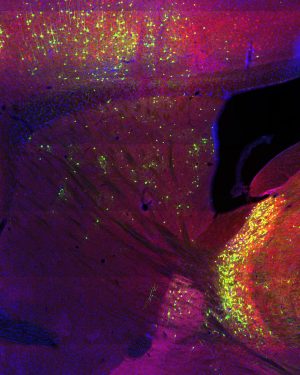
May 1, 2018
Salk scientists find differences in communication pathways to two cell types implicated in psychiatric and movement disorders
Salk scientists find differences in communication pathways to two cell types implicated in psychiatric and movement disorders
LA JOLLA—If 95 percent of your neighbors are chatty and outgoing, you probably know more about them than the 5 percent who are reclusive and shy. It’s similar for neuroscientists who study the striatum, a brain region associated with action control and learning: they know a lot more about the 95 percent of neurons that communicate with outside regions than the 5 percent that communicate only within the striatum.

Click here for a high-resolution image.
Credit: Salk Institute
Salk Institute scientists mapped where information to the 5 percent is coming from and, in the process, clarified the relationship of two types of neurons to psychiatric and sensory/movement disorders, respectively. The different communication pathways these two types of “interneurons” represent may offer new drug targets for disorders as diverse as Parkinson’s, OCD, depression and autism. The work appeared in the journal eLife on May 1, 2018.
“The difficulty with studying striatal interneurons is that there are so few of them,” says Xin Jin, an associate professor in Salk’s Molecular Neurobiology Lab and senior author of the new paper. “It has been really challenging to target just a dozen brain cells and learn anything about cause and effect.”
The two interneuron types studied, ChAT and PV, comprise less than 2 percent of the total neurons in the striatum. What little is known about their function in the striatum comes from postmortem studies of human brain tissue. Compared to healthy brain tissue, samples from patients with depression and schizophrenia show decreases in ChAT interneurons, while samples from people with movement disorders such as Huntington’s disease, Tourette syndrome and dystonia show reductions in PV interneurons.
But with so few of each type in the brain, traditional techniques such as monitoring the activity of brain cells couldn’t yield sufficient data to confirm the exact function of these interneurons. So Jin’s lab took a more global approach. They used a technique pioneered by fellow Salk scientist Edward Callaway to harness a modified rabies virus tagged with a fluorescent marker to track which brain cells were communicating with each other in mice.
In doing so, the Salk team discovered several interesting things: first, that communication signals to the ChAT neurons came primarily from areas of the brain responsible for cognitive functions; and, second, that input to the PV neurons came mainly from sensorimotor areas. Together, these bolstered the clinical observations in human patients and implied their different roles in cognitive versus sensorimotor function. In addition, the team discovered a novel connection no one observed before: a cluster of neurons called the thalamic reticular nucleus (TRN) that project directly to the striatum. This was surprising because the TRN was thought to be limited in its projections to the brain region for which it is named, the thalamus.

Click here for a high-resolution image.
Credit: Salk Institute
Because the TRN result was so unexpected, Jin and first author Jason Klug next sought to verify their initial rabies result with two independent methods: optogenetics, which uses light to stimulate neurons to fire, and electrophysiology, which records electrical activity. While causing neurons in the TRN to fire, the researchers recorded whether PV interneurons in the striatum responded. The neurons did, which validated the evidence for TRN-striatal communication.
“The combination of techniques was crucial to this finding and allowed us to explore undiscovered or underappreciated inputs to striatal neurons. We employed rabies tracing to screen the anatomical inputs, and used electrophysiology and optogenetics to verify the functional connectivity,” says Klug, who is a research associate at Salk.
Adds Jin, “The TRN has long been thought to function as an attentional ‘spotlight,’ initially proposed by Francis Crick in 1984. Our discovery offers a previously unknown mechanism to coordinate attention and action through TRN-striatal communication, and has important implications for brain functions in both health and disease.”
The lab’s work will continue to define the functions of ChAT and PV interneurons in controlling behavior, and to investigate them as potential targets for treating psychiatric and neurological diseases.
Other authors included Max D. Engelhardt, Cara N. Cadman, Hao Li, Jared B. Smith, Sarah Ayala, Elora W. Williams and Hilary Hoffman of Salk.
The work was funded by the National Institutes of Health (R01NS083815 and R01AG047669), the Dana Foundation, the Ellison Medical Foundation and the Whitehall Foundation.
JOURNAL
eLife
AUTHORS
Jason R. Klug, Max D. Engelhardt, Cara N. Cadman, Hao Li, Jared B. Smith, Sarah Ayala, Elora W. Williams, Hilary Hoffman and Xin Jin.
Office of Communications
Tel: (858) 453-4100
press@salk.edu
Unlocking the secrets of life itself is the driving force behind the Salk Institute. Our team of world-class, award-winning scientists pushes the boundaries of knowledge in areas such as neuroscience, cancer research, aging, immunobiology, plant biology, computational biology and more. Founded by Jonas Salk, developer of the first safe and effective polio vaccine, the Institute is an independent, nonprofit research organization and architectural landmark: small by choice, intimate by nature, and fearless in the face of any challenge.